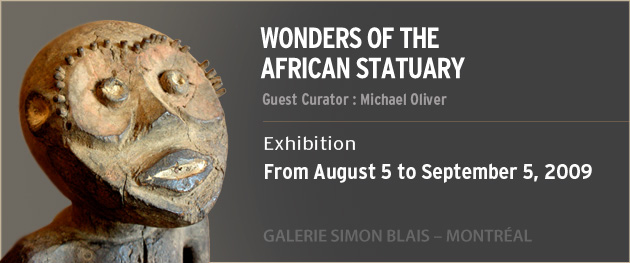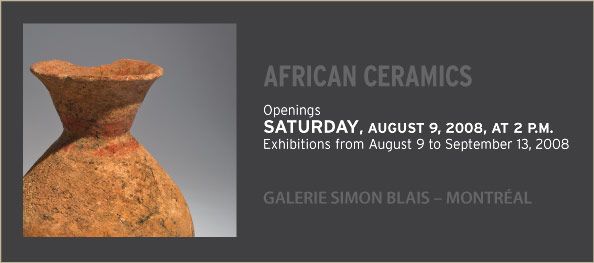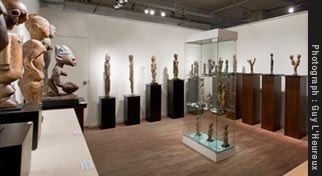Inseparable – Binaries in Tribal Art : Galerie Simon Blais
Archives



Exhibition view of the Lobi room
Chosen objects : Lobi, Ibo and more…
Seven years ago, I acquired my very first piece of “genuine” tribal art—a splendid, entirely unpretentious, small Lobi figure—without exactly knowing just why it had so attracted me. I can better explain that reaction today, and am finally able to describe through both words and the works themselves what has become my passion as both a collector and a dealer of modern and contemporary art. This sudden fascination marked a change in the direction of my interests as a collector in that the acquisition of this example of “figurative” art was, in fact, a major turning point: never before had I the slightest interest for representations of the human figure in the art that was part of my life! It took a little Lobi figure to make me understand how I needed to be surrounded by a certain vision of the human, as perceived by the artists of today… and of centuries past.
Largely unknown fifty years ago, the usually wooden objects and sculptures of Lobi art, beyond their primarily ritual and sacrificial function, have an affinity with some Western folk traditions. Let me explain: in Lobi sculpture, volumes are unevenly distributed, and bodies are rarely represented in a symmetrical fashion. Too-large or too-small heads top elongated necks, arms are exaggeratedly long, hands enormously large and, especially, trunks and limbs wildly disproportionate. However, these deceptively naïve elements are particularly endearing to the collector of modern and contemporary art that I am. Another feature of the works gathered here is their look of very great age. The heavily eroded woods (generally on the figures’ hands and feet), the patinas reflecting long, meticulous use (oiled or encrusted woods that have literally been “fed” and then polished through ritual use), the deep cracks and incrustations—all this contributes, in the eyes of specialists, collectors and dealers such as myself, to the mysterious beauty of these works.
This collection comprises thirty-five Lobi sculptures, as well as a group of large Ibo figures. The modernity of the Ibo works fascinates me. The very pronounced geometry of their volumes, as well as their representations of facial scarring and hair styles, although clearly referencing the type of beauty traditionally prized by this Nigerian people, find a contemporary echo in current Western trends of bodily adornment, including tattooing and piercing among European and North American men and women, and the deliberately daring coiffures of the counterculture.
Gathered together under the theme of the representation of the human figure and, notably, the human face, in my opinion these works possess all the greatness and intensity of the most up-to-the-minute art available in the West today. Placed side by side with contemporary paintings, the forms and volumes of these African sculptures are more than a fitting match to the art of our own part of the world.
A number of remarkable works from other sub-Saharan African cultures, in particular the Dinka (Sudan), Sangara (Tanzania), Dogon and Bozo (Mali), Mossi and Dagari (Burkina Faso) and Jukun, Montol, and Yoruba (Nigeria), are also presented, all representing the human figure for ritual purposes.
Simon Blais
August 2007
FACES OF AFRICA
ANCIENT SCULPTURE FROM SUB-SAHARAN AFRICA
EXHIBITION FROM AUGUST 15 TO SEPTEMBER 29, 2007
GALERIE SIMON BLAIS – MONTREAL